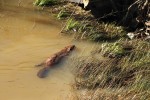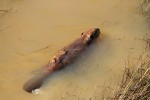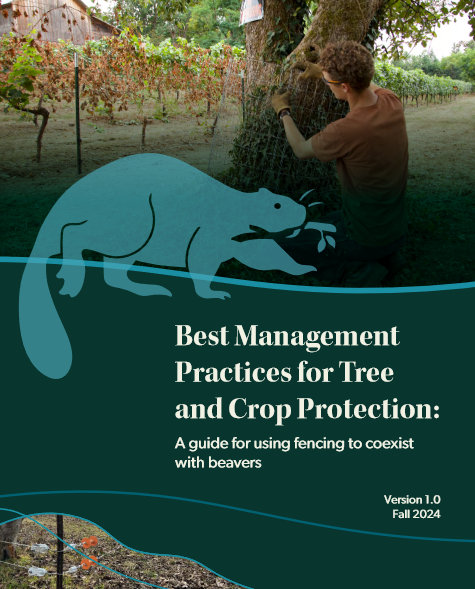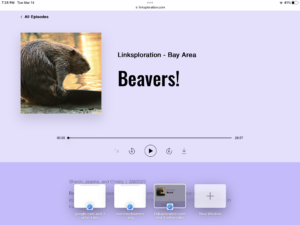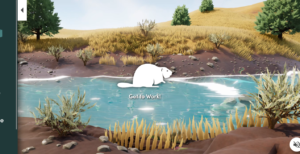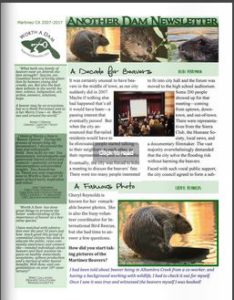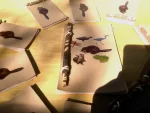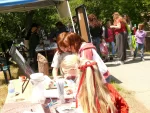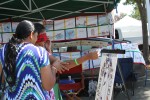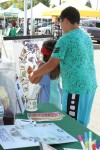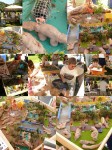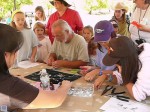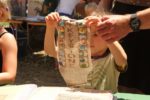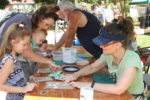What a pleasant surprise! An article from Ohio about beavers that isn’t discussing how to trap them! Richland County is in the middle of the state, down below Lake Eerie.
A living heritage: Beaver in Richland County
It has been more than two centuries since beaver shaped the rivers and creeks of Richland County, but at long last they are quietly reclaiming little pools of their ancestral wetlands.
When the first settlers came to the forested hills of Richland County in the early 1800s they encountered many wild animals we seldom or never find here today. Their letters and diaries and later reminiscences document the abundance of wolves and bears, otters and panthers.
 But there is one common native of the American wilderness that was never listed in their memoirs because, by the time the pioneers arrived in the early 1800s, this critter had already been hunted out of these lands.
But there is one common native of the American wilderness that was never listed in their memoirs because, by the time the pioneers arrived in the early 1800s, this critter had already been hunted out of these lands.
That was the beaver.
The last people who saw beaver in Richland County were Wyandot and Huron hunters, or French fur trappers. The Richland beaver clan gradually departed here through the decades of the 1700s: carried out bundle at a time as furry pelts.
The fur was toted to a frontier trading post; then made its way to the coast where it was loaded on a ship and sailed across the ocean. Somewhere in Europe the fur was processed into waterproof felt material, and then manufactured into hats.
You’ll note the date that Richland last saw beavers was about 100 years before California lost out. It’s funny to think about the cascading domino effect that swept the nation in slow motion, East to West, over many years ago as the loss of beavers back drove folks ever west to find more. Funny in an eerie kind of way, I mean, not at all amusing to think about the drought and wildlife devastation that followed the hunt.
There were a lot of people in Europe in those days and they all wore hats.
 The best hats were made from beaver fur because these warm blooded animals evolved in chilly ponds so their skins are naturally designed to keep water out and heat in. If a hat was to shed rain it was well to be manufactured from the soft, dense under fur of a beaver.
The best hats were made from beaver fur because these warm blooded animals evolved in chilly ponds so their skins are naturally designed to keep water out and heat in. If a hat was to shed rain it was well to be manufactured from the soft, dense under fur of a beaver.
When permanent residential villages were established along the Clear Fork and the Black Fork in the 1700s, they were peopled mostly with clans of diverse tribes who had been displaced from their homelands by Beaver War conflicts.
The other major impact that the Beaver Wars had on Richland County was the complete extermination of Mohican watershed beavers.
Richland County happens to be placed on the continent at a particularly generous confluence of influences—bedrock stratum and weather pattern—that produces a wealth of water resources. We have a ‘Spring field’ township precisely because water is so plentiful it cannot be contained under the ground.
So imagine what happened when these two dynamic natural elements—water and beaver—were free to interact in wild genius.
Back then every Richland stream, creek, and tributary was undoubtedly repurposed by beaver, and shaped by their dams. The image we have today, of meandering streams flowing through the bottom of carved creek beds, did not exist in the era of beaver. These same waterways 300 years ago would have been seen as a series of small beaver ponds.
True. And every single one of those ponds were filled with wood duck and otter and trout so thick a man could walk across them. But why dwell on the past. It was a great idea turning all those little furry engineers into gold, right? That’s why we’re still doing it every day – trading our clear streams for fracking waste water and letting oil wells tunnel into every public land. Because what good is the environment if you can’t spend it. Amirite?
Wetlands
 Since the beaver disappeared 200 years ago Richland County has transformed: dried out, plowed and planted, and paved so dramatically the animals could hardly be expected to recognize the place. Yet, interestingly enough, when they made their way back here 20-30 years ago, one of the places they gravitated toward is a wetland that they may well have created themselves hundreds of years ago.
Since the beaver disappeared 200 years ago Richland County has transformed: dried out, plowed and planted, and paved so dramatically the animals could hardly be expected to recognize the place. Yet, interestingly enough, when they made their way back here 20-30 years ago, one of the places they gravitated toward is a wetland that they may well have created themselves hundreds of years ago.
Almost like a homing instinct they have set up camp once again at the headwaters of the Clear Fork River.
It is marshland today, and seemingly created through construction of the Clear Fork Reservoir. Yet documents from engineers in the 1940s show that the area was already waterlogged before they built the dam.
In fact records from 200 years ago, when surveyors first paced off the wilderness of Richland County, indicate there was a backlogged stream in the place even then.
This marsh is situated within a stretch of landscape that is otherwise well drained. By the surface and subsurface evidence, a local geologist and forensic landscaper suggests that this bit of wetland may well have been first terraformed by beaver engineers hundreds or thousands of years ago in order to create a comfy neighborhood for their community.
Perhaps the beavers who navigate the marsh today are direct descendants of the ones who started the swamp long ago when they backed up the waters of the Clear Fork.
I think this author is having a wistful moment wondering what the watershed looked with a healthy beaver population. Good for him. I know I always am. I can’t imagine if it will ever get that way again, but if beavers have their way they will turn our ruined city waterways to wetlands the same way they have transformed Chernobyl. They won’t need our help or invitation either. I don’t know where the human race will be when that happens, but I suspect the beavers won’t miss it.
Timothy Brian McKee is a featured columnist on our site every Saturday with a column titled Native Son. Every Tuesday, he taps into his knowledge and collection of historical photos and bring us Then & Now, a brief glance at the way things were.



 they compel more expansive definitions for this very term. We typically engineer ecosystems by neatening and bleakening them with inert structures, often at the expense of other species. But the organic approach of Castor canadensis actually increases biodiversity, including direct contributions to over 25 percent of herbaceous plant species along forested rivers and streams.
they compel more expansive definitions for this very term. We typically engineer ecosystems by neatening and bleakening them with inert structures, often at the expense of other species. But the organic approach of Castor canadensis actually increases biodiversity, including direct contributions to over 25 percent of herbaceous plant species along forested rivers and streams. US Forest Service biologist Kent Woodruff knows that many landowners consider beavers problematic, but his leadership on the project has shown them how these animals can aid us in timely, cost-effective ways. Woodruff can talk about beavers one minute as though they are venerable elders; in another, they might be an Allen wrench, just the right size; in the next, he might be on his knees, pointing out to some visiting schoolkid what makes one beaver’s tail unlike all the others. It’s no wonder that Woodruff has been dubbed a “beaver whisperer.” Since 2008, the project has relocated over 300 beavers around the Methow Valley watershed, most to headwater streams on public land.
US Forest Service biologist Kent Woodruff knows that many landowners consider beavers problematic, but his leadership on the project has shown them how these animals can aid us in timely, cost-effective ways. Woodruff can talk about beavers one minute as though they are venerable elders; in another, they might be an Allen wrench, just the right size; in the next, he might be on his knees, pointing out to some visiting schoolkid what makes one beaver’s tail unlike all the others. It’s no wonder that Woodruff has been dubbed a “beaver whisperer.” Since 2008, the project has relocated over 300 beavers around the Methow Valley watershed, most to headwater streams on public land. In the past several decades, Portland, with its progressive urban growth boundary to constrict sprawl and keep the city green, has become a destination of the eco-friendly. And ever since officials from nearby Tigard, Oregon rashly breached a beaver dam, locals have started to speak up for their state animal. Greater Portland’s urban parks have become oases touted for “beaver watching” opportunities, and wherever possible, beavers are allowed to do what beavers do. The sheer curiosity these rodents provoke has shown that our natural aesthetics are wildly adaptable. Where the beavers draw too close for comfort, there are options. People are learning to foil the fellers from taking down cherished trees with hardy fences, or by coating the trunks with an abrasive paint-sand mixture.
In the past several decades, Portland, with its progressive urban growth boundary to constrict sprawl and keep the city green, has become a destination of the eco-friendly. And ever since officials from nearby Tigard, Oregon rashly breached a beaver dam, locals have started to speak up for their state animal. Greater Portland’s urban parks have become oases touted for “beaver watching” opportunities, and wherever possible, beavers are allowed to do what beavers do. The sheer curiosity these rodents provoke has shown that our natural aesthetics are wildly adaptable. Where the beavers draw too close for comfort, there are options. People are learning to foil the fellers from taking down cherished trees with hardy fences, or by coating the trunks with an abrasive paint-sand mixture.


